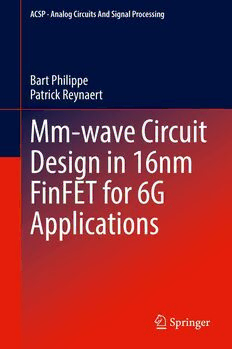
Mm-wave Circuit Design in 16nm FinFET for 6G Applications PDF
Preview Mm-wave Circuit Design in 16nm FinFET for 6G Applications
Analog Circuits and Signal Processing SeriesEditors MohammedIsmail,KhalifaUniversity,Dublin,OH,USA MohamadSawan,18,ShilongshanRoad,SchoolofEngineering,WestlakeUniver- sity,Hangzhou,Zhejiang,China The Analog Circuits and Signal Processing book series, formerly known as the Kluwer International Series in Engineering and Computer Science, is a high level academic and professional series publishing research on the design and applicationsofanalogintegratedcircuitsandsignalprocessingcircuitsandsystems. Typically per year we publish between 5-15 research monographs, professional books, handbooks, and edited volumes with worldwide distribution to engineers, researchers, educators, and libraries. The book series promotes and expedites the dissemination of new research results and tutorial views in the analog field. There is an exciting and large volume of research activity in the field worldwide. Researchersarestrivingtobridgethegapbetweenclassicalanalogworkandrecent advancesinverylargescaleintegration(VLSI)technologieswithimprovedanalog capabilities. Analog VLSI has been recognized as a major technology for future information processing. Analog work is showing signs of dramatic changes with emphasisoninterdisciplinaryresearcheffortscombiningdevice/circuit/technology issues. Consequently, new design concepts, strategies and design tools are being unveiled. Topics of interest include: Analog Interface Circuits and Systems; Data converters; Active-RC, switched-capacitor and continuous-time integrated filters; Mixed analog/digital VLSI; Simulation and modeling, mixed-mode simulation; Analog nonlinear and computational circuits and signal processing; Analog Arti- ficial Neural Networks/Artificial Intelligence; Current-mode Signal Processing; Computer-Aided Design (CAD) tools; Analog Design in emerging technologies (Scalable CMOS, BiCMOS, GaAs, heterojunction and floating gate technologies, etc.); Analog Design for Test; Integrated sensors and actuators; Analog Design Automation/Knowledge-based Systems; Analog VLSI cell libraries; Analog prod- uctdevelopment;RFFrontends,WirelesscommunicationsandMicrowaveCircuits; Analogbehavioralmodeling,AnalogHDL. Bart Philippe • Patrick Reynaert Mm-wave Circuit Design in 16nm FinFET for 6G Applications BartPhilippe PatrickReynaert ESAT-MICAS ESAT-MICAS KULeuven KULeuven Leuven,Belgium Leuven,Belgium ISSN1872-082X ISSN2197-1854 (electronic) AnalogCircuitsandSignalProcessing ISBN978-3-031-11223-2 ISBN978-3-031-11224-9 (eBook) https://doi.org/10.1007/978-3-031-11224-9 ©TheEditor(s)(ifapplicable)andTheAuthor(s),underexclusivelicensetoSpringerNatureSwitzerland AG2023 Thisworkissubjecttocopyright.AllrightsaresolelyandexclusivelylicensedbythePublisher,whether thewholeorpartofthematerialisconcerned,specificallytherightsoftranslation,reprinting,reuse ofillustrations,recitation,broadcasting,reproductiononmicrofilmsorinanyotherphysicalway,and transmissionorinformationstorageandretrieval,electronicadaptation,computersoftware,orbysimilar ordissimilarmethodologynowknownorhereafterdeveloped. Theuseofgeneraldescriptivenames,registerednames,trademarks,servicemarks,etc.inthispublication doesnotimply,evenintheabsenceofaspecificstatement,thatsuchnamesareexemptfromtherelevant protectivelawsandregulationsandthereforefreeforgeneraluse. Thepublisher,theauthors,andtheeditorsaresafetoassumethattheadviceandinformationinthisbook arebelievedtobetrueandaccurateatthedateofpublication.Neitherthepublishernortheauthorsor theeditorsgiveawarranty,expressedorimplied,withrespecttothematerialcontainedhereinorforany errorsoromissionsthatmayhavebeenmade.Thepublisherremainsneutralwithregardtojurisdictional claimsinpublishedmapsandinstitutionalaffiliations. ThisSpringerimprintispublishedbytheregisteredcompanySpringerNatureSwitzerlandAG Theregisteredcompanyaddressis:Gewerbestrasse11,6330Cham,Switzerland Preface Our online activity is growing at an unprecedented rate. New online applications change the way we communicate, work, play, watch entertainment and so much more.Therequirementsputonthenetworktoenabletheseapplicationsarealready stringentandcongesttheavailablebandwidth.Futureapplicationssuchasvirtualor extended reality will put even more stringent requirements in place. For example, toprovideahighresponsetimeandincreasedvideostreamingquality,thelatency needstodecreaseanddataratesneedtoimproveuptoa50-foldincrease.Thesixth- generation(6G)mobilenetworkswilladdressthesechallengesbymakingextensive useofthelargeavailablebandwidthatmm-wavefrequencies. CMOSisthetechnologyofchoiceformass-producedcircuits.Itprovideshigh yields at low costs, while the continued downscaling has led to fast transistors allowingtheimplementationofmm-wavecircuits.Thepossibilitytointegratemm- waveandlow-poweranalogbuildingblockswithdigitalsignalprocessinghasmade CMOS a key technology for mass adoption. Deeply scaled CMOS has, therefore, gained growing attention for future 6G mm-wave fronts from both industry and research institutes. Unfortunately, aggressive technology scaling does not only providebenefitsbutalsocomeswithitsownchallenges.Firstly,thesmallersupply voltagelimitsthemaximalvoltageswing,limitinglinearity,SNR,andoutputpower. Secondly, metal interconnects get thinner and closer to the substrate resulting in larger resistances, limiting the achievable mm-wave performance. The advent of FinFET technology to continue digital density scaling by using the vertical space instead of smaller planar transistors has resulted in temporary stagnation in the mm-waveperformance.Thenew3Dtransistortopologyintroducesnewchallenges and changes the design trade-offs in the mm-wave designs compared to planar technologies. This book looks at the impact on mm-wave circuit design, for going from a planarCMOStechnologytowardaFinFETtechnology.Itintroducestechniquesand practicestorealizehigh-performancemm-wavecircuitsoperatingbetween90GHz and 170GHz. First, a more in-depth look at the elementary active and passive componentsistaken.TheFinFETtransistorisanalyzedandoptimizedformm-wave performance. The effects of nanoscale technology scaling on widely used passive v vi Preface components and the corresponding impact on mm-wave circuits are discussed. At the end of the chapter, the active and passive components are combined to form a fundamental mm-wave amplifier block. Secondly, the challenges of frequency generation in a CMOS FinFET technology are discussed. The challenges are approachedfromtwoviewpoints,whichleadtotwodesignexamples;afundamental andaharmonicoscillator.Thethirdchapterdiscussesthebasicsofmm-wavepower amplifiers in a FinFET technology. The maximal power limits are discussed and solutions to these challenges are proposed. This results in the design example of a power combining power amplifier implemented in a 16 nm FinFET technology. Finally,theissueofthelowefficiencyofmm-wavepoweramplifiersabove100GHz isdiscussed.Thisleadstoanovelpoweramplifiertopologywithimprovedback-off efficiency and linearity. In a design example, the power amplifier is implemented inadirectconversiontransmitter,in16nmFinFETtechnology,demonstratingdata transmissionupto44Gbps. Leuven,Belgium BartPhilippe Leuven,Belgium PatrickReynaert April2022 Contents 1 Introduction .................................................................. 1 1.1 TowardtheSixth-Generation(6G)MobileNetworks................. 1 1.1.1 MillimeterWavetoIncreaseDataRates....................... 1 1.2 MillimeterWaveinFinFETCMOS,theNextStep ................... 3 1.3 BookOutline............................................................ 5 References..................................................................... 5 2 BasicComponentsinmm-WaveDesign................................... 7 2.1 Actives................................................................... 7 2.1.1 f ,f aFoMformm-WaveTransistors.................... 8 T max 2.1.2 TheEffectofScaling;mm-WaveinFinFET.................. 10 2.1.3 TransistorLayoutandmm-WavePerformance................ 12 2.2 Passives.................................................................. 17 2.2.1 Capacitors....................................................... 18 2.2.2 Inductors ........................................................ 20 2.2.3 Transformers.................................................... 22 2.2.4 TransmissionLines............................................. 25 2.3 BasicDesignofmm-WaveCircuits.................................... 26 2.3.1 ACapacitiveNeutralizedmm-WaveAmplifier ............... 26 2.3.2 Designofmm-WaveInterconnects ............................ 28 2.4 Conclusion .............................................................. 33 References..................................................................... 34 3 FrequencyGeneration....................................................... 37 3.1 VCOBasics ............................................................. 37 3.1.1 BriefonPhaseNoise ........................................... 38 3.1.2 FrequencyTuning............................................... 40 3.2 LOArchitecturesandTrendsatmm-Wave............................ 42 3.3 ChallengesofaDeeplyScaledTechnologyatmm-Wave............. 44 3.4 A4thOrderTransformer-BasedResonator............................ 47 3.5 DesignExample:AFundamentalOscillator........................... 50 3.5.1 TheCross-CoupledPair........................................ 50 vii viii Contents 3.5.2 TheResonatorDesign.......................................... 52 3.5.3 MeasurementResults........................................... 54 3.6 DesignExample:AHarmonicOscillator.............................. 55 3.6.1 BasicPrinciple ................................................. 55 3.6.2 ProposedDesign ............................................... 57 3.6.3 OutputBuffers .................................................. 58 3.6.4 MeasurementResults........................................... 61 3.7 Conclusion .............................................................. 63 References..................................................................... 66 4 PowerAmplification......................................................... 69 4.1 Introduction ............................................................. 69 4.2 PowerAmplifierBasics................................................. 69 4.2.1 GainandPower................................................. 69 4.2.2 Efficiency........................................................ 71 4.2.3 PALinearity..................................................... 72 4.2.4 PAClassesandBiasing......................................... 73 4.2.5 Challengeatmm-WaveinaDeeplyScaledTechnology...... 78 4.3 DesignExample:AClass-ATwo-WayPowerCombining D-BandPAin16nmFinFET........................................... 83 4.3.1 Designofthe16nmFinFETTransistor ....................... 83 4.3.2 Build-upofthePowerAmplifier............................... 85 4.3.3 MeasurementResults........................................... 88 4.4 Conclusion .............................................................. 93 References..................................................................... 94 5 AD-bandDirect-ConversionTransmitterwithEnhancedPA.......... 97 5.1 EfficiencyEnhancementTechniques................................... 97 5.1.1 CommonEfficiencyEnhancementTechniques................ 97 5.1.2 ASequentialPowerAmplifier ................................. 101 5.1.3 Conclusion ...................................................... 105 5.2 LinearizationTechniquesbyDynamicBias .......................... 105 5.2.1 AM–AMCompensation........................................ 105 5.2.2 AM–PMCompensation ........................................ 106 5.3 DesignExample:ADirect-ConversionTXwithEnhanced PA ....................................................................... 110 5.3.1 TheDynamicBiasEnhancedPA .............................. 110 5.3.2 TheI/QModulatorandLOGeneration........................ 114 5.4 MeasurementsandDiscussion ......................................... 118 5.4.1 PowerAmplifierMeasurements ............................... 119 5.4.2 TransmitterMeasurements..................................... 123 5.5 Conclusion .............................................................. 131 References..................................................................... 132 Index............................................................................... 135 Acronyms and Symbols AMAM Amplitudemodulationtoamplitudemodulation AMPM Amplitudemodulationtophasemodulation AWG Arbitrarywaveformgenerator BEOL Backendofline BER Biterrorrate BiCMOS BipolarCMOS BW Bandwidth CPW Coplanarwaveguide DAC Digitaltoanalogconverter DC Directcurrent DE Drainefficiency DRC Designrulecheck DWG Dielectricwaveguide EIRP Equivalentisotropicallyradiatedpower EVM Errorvectormagnitude FFT Fastfouriertransform FinFET Finfield-effecttransistor FoM Figureofmerit FoMt Figureofmerittuning(usedforoscillators) FSPL Freespacepathloss FSU SpectrumanalyzerfromRohde&Schwarz FSW SpectrumanalyzerfromRohde&Schwarz GSG Ground-signal-ground IF Intermediatefrequency IFFT Inversefastfouriertransform IL Insertionloss IM Intermodulation IMRR Imagerejectionratio IR Infrared ISI Intersymbolinterference LNA Lownoiseamplifier ix x AcronymsandSymbols LO Localoscillator LOFT Localoscillatorfeedthrough MIM-capacitor Metal-insulator-metalcapacitor MOM-capacitor Metal-oxide-metalcapacitor MOS complementaryMetaloxidesemiconductor MOS Metaloxidesemiconductor MUT Materialundertest MUX Multiplexer NF Noisefigure NMOS N-typemetaloxidesemiconductor OP1dB Outputreferred1dBcompressionpoint PA Poweramplifier PAE Poweraddedefficiency PAPR Peaktoaveragepowerratio PBO Powerback-off PCB Printedcircuitboard PDK Processdesignkit PLL Phase-lockedloop PM5 EricksonpowermeterfromVirginiadiodes PMOS P-typemetaloxidesemiconductor PN Phasenoise PSD Powerspectraldensity PSG SignalgeneratorfromKeysight PVT Processvariationandtemperature QAM Quadratureamplitudemodulation R&S Rohde&Schwarz RBW Resolutionbandwidth RDL Redistributionlayer RF Radiofrequency SiGe Silicon-germanium SNR Signaltonoiseratio SR Samplerate TIA Transimpedanceamplifier TL Transmissionline TSMC Taiwanesesemiconductormanufacturingcompany VDI VirginiaDiodesInc. VNA Vectornetworkanalyzer T Temperature W Bandwidth C Channelcapacity channel S Signaltonoiseratio N P Power f Frequency d Distance λ Wavelength
